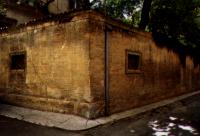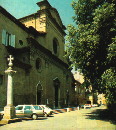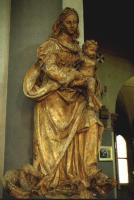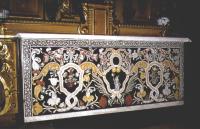|
|
Where walls bar access to gardens to be imagined, near churches well |
|
|
|
|
In various points of the city with differing histories, green areas can be glimpsed beyond protective walls. Here gates are kept firmly locked, but even if it strictly private, this greenery still gives the city some intriguing corners, often encountered in quiet spots away from modern traffic and commercial centres. Corso Vittorio Emanuele II/Via Sant'Orsola If we move into the northern part of the city, laid out by the Este family in the XVI Century, we can find traces of large private gardens, kept strictly closed. The grounds of palazzo Boschetti run along via Sant'Orsola, where a long, straight wall only partly conceals the greenery of the inner garden. We are unable to get any closer, and what lies beyond the wall can only be guessed at, on the basis of what can be seen: lombardy poplars, sycamores, horse chestnuts and a tall ailanthus, whose flowers in late spring are the same yellow and ochre shades as the palazzo itself. 
Via dei Servi/Vicolo Grassetti In the very heart of the city, where open spaces are very limited, a kind of illusion of greenery can be created. One example is on the corner of via dei Servi and vicolo Grassetti. The area left beside the building for the garden is tiny, but it is used to striking effect. The garden wall itself is very attractive, repeating the motif of the windows of the palazzo, while the densely planted trees give the impression of abundant greenery, as the wall is surmounted by two tall catalpas with their large leaves, limes, creepers and opopanaxes, which bear tufts of pink flowers. Via del Taglio - Via Castel Maraldo Where via Taglio ends in its V junction with via Cardinal Morone there is a small triangular square in front of the church of S, Maria della Pomposa; open chases and the signs of several reworkings tell us that the church's facade, with its single large window, is unfinished. On the left stands the strangely shaped priest's house, with a stone plaque over the entrance reminding us that for 34 years it was the home of the famous historian L.A. Muratori, priest of the parish, who also died there in 1750. The church itself, with its single nave and rectangular apse, has very simple lines that blend well with those of the adjoining building, in brick of the same colour, where Muratori lived and which now houses both the Museo Muratoriano (displaying his works and various relics) and the Deputazione di Storia Patria per le Antiche Province Modenesi (a local history organisation). Apart from its connection with Muratori, the place is worth a visit for any tourist who likes odd nooks and corners whose charm is created by the sum of their parts. The open area between the church and Via Castel Maraldo is surrounded by buildings with arcades and high walls, beyond which the vegetation of partly concealed gardens can be seen. Beneath the shade of a yew and a magnolia which emerge from the small church garden, beside the spout of a fountain flowing from a grotesque head, there is a joking Latin dedication by Telesforo Fini, who gave the fountain 
Via San Pietro/Rua Pioppa/Via Mascherella
There is a small square in front of
the church of San Pietro, an antique monastic foundation close
to the city walls which have now been replaced by the park of
viale delle Rimembranze. Here, beyond the row of nettle trees
which lines the street, there is an enclosed courtyard, a quiet
corner that seems suspended in time. Beside it, on the corner
of rua Pioppa and via Mascherella, a garden is hidden behind a
high wall which is still not high enough to prevent an ilex and
a large laurel from emerging above it. Mentioned here only for
its contribution to the appeal of the square to which it gives
its name, the church of S. Pietro is also of architectural interest.
First and foremost, it is one of the few XVI Century religious
buildings to have survived in Modena.
A "Begarelli tour" of Modena is a fascinating experience; as well as the churches of S. Pietro, S. Francesco and S. Agostino, it also includes S. Domenico, where there is a Begarelli group, and the Cathedral, with the Nativity in its right-hand nave. The Galleria Estense (Palazzo dei Musei) contains the "Madonna and Child" and a number of small works. Last but not least, the Museo di Arte Medievale e Moderna (Palazzo dei Musei) has the "Madonna di Piazza" and the "Head of an Angel". |
|
© 1997 - Provincia di Modena - Made by
|
|
 It is in a hybrid style
with many references to both the Romanesque and the Gothic, while
its facade shows clear signs of Renaissance taste, in the lesenes
which divide up the spaces, in the three doors whose white marble
decorations stand out against the brick background, and in the
brickwork frieze in which sea-horses with entwined tails and satyrs
recall iconographic themes very common in the XVI Century. But
the most important architectural glory of the S. Pietro complex
is the Chiostro Grande, the large cloister at the centre of the
former Benedictine Monastery adjoining the church, divided in
classical style by the eyes of the arcade with ionic columns,
surmounted by an upper row of windows.
It is in a hybrid style
with many references to both the Romanesque and the Gothic, while
its facade shows clear signs of Renaissance taste, in the lesenes
which divide up the spaces, in the three doors whose white marble
decorations stand out against the brick background, and in the
brickwork frieze in which sea-horses with entwined tails and satyrs
recall iconographic themes very common in the XVI Century. But
the most important architectural glory of the S. Pietro complex
is the Chiostro Grande, the large cloister at the centre of the
former Benedictine Monastery adjoining the church, divided in
classical style by the eyes of the arcade with ionic columns,
surmounted by an upper row of windows.
 Now split between the
Military Headquarters, a Middle School and the S. Pietro parish
hall, the former convent lost its chief works of art as early
as 1819. These are the four statues which stand on pedestals
beside the columns of the central nave of the church of S. Pietro,
with two more originally in the church of S. Francesco, one of
them double. The work of Begarelli, they cannot fail to attract
the attention of anyone entering the church.
Now split between the
Military Headquarters, a Middle School and the S. Pietro parish
hall, the former convent lost its chief works of art as early
as 1819. These are the four statues which stand on pedestals
beside the columns of the central nave of the church of S. Pietro,
with two more originally in the church of S. Francesco, one of
them double. The work of Begarelli, they cannot fail to attract
the attention of anyone entering the church.